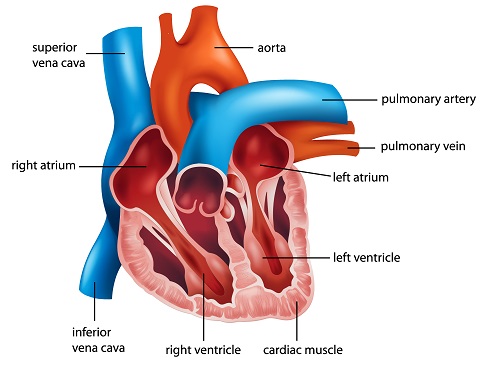The inferior vena cava, or IVC, carries blood from the lower half of the body.
 It collects blood from the veins that connect to the tissues lower than the heart and returns this blood to the right atrium of the heart. The IVC is the largest vein in the human body, which runs from the heart all the way down through the abdomen. The IVC and its connections drain blood from the feet, legs, thighs, pelvis, and abdomen and carry it to the heart. If this vein cannot be filtered or if a patient cannot take blood thinners, then an IVC filter will need to be placed into the body.
It collects blood from the veins that connect to the tissues lower than the heart and returns this blood to the right atrium of the heart. The IVC is the largest vein in the human body, which runs from the heart all the way down through the abdomen. The IVC and its connections drain blood from the feet, legs, thighs, pelvis, and abdomen and carry it to the heart. If this vein cannot be filtered or if a patient cannot take blood thinners, then an IVC filter will need to be placed into the body.
What is an IVC Filter?
An inferior vena cava (IVC) filter is a type of vascular filter, a medical device that is implanted by interventional radiologists or vascular surgeons into the inferior vena cava to prevent pulmonary emboli (PE). The placement of the IVC filter will be recommended if patients are at high risk for developing a clinically significant PE and cannot be sufficiently use anticoagulants. Anticoagulants are drugs that prevent the clotting of blood, so the IVC filter does the job of these drugs when people cannot take them.
Placement of the IVC Filter
IVC filters are placed through an insertion inside the blood vessels. Before recent technological advances, filters had to be inserted surgically; however, modern filters can be compressed into much smaller catheters and placed through veins in the groin, the internal jugular vein in your neck, or arm veins. Where we place the filter is based on location of any blood clots within your veins. To place the filter, a catheter is channeled into the IVC using an x-ray to control it, then the filter is shunted through the catheter and is installed in the chosen location. It is placed just below the connection of the IVC and lowest vein in the kidney.
IVC Filter Placement
IVC filters are placed when a patient has a history or risk of developing any of the following conditions:
- Deep vein thrombosis (DVT)
- Blood clots
- Pulmonary embolus







